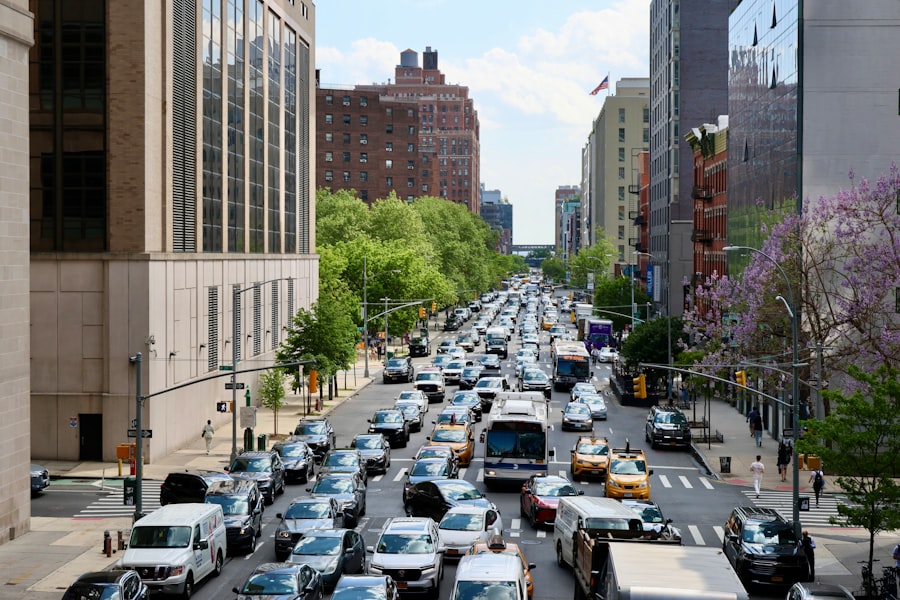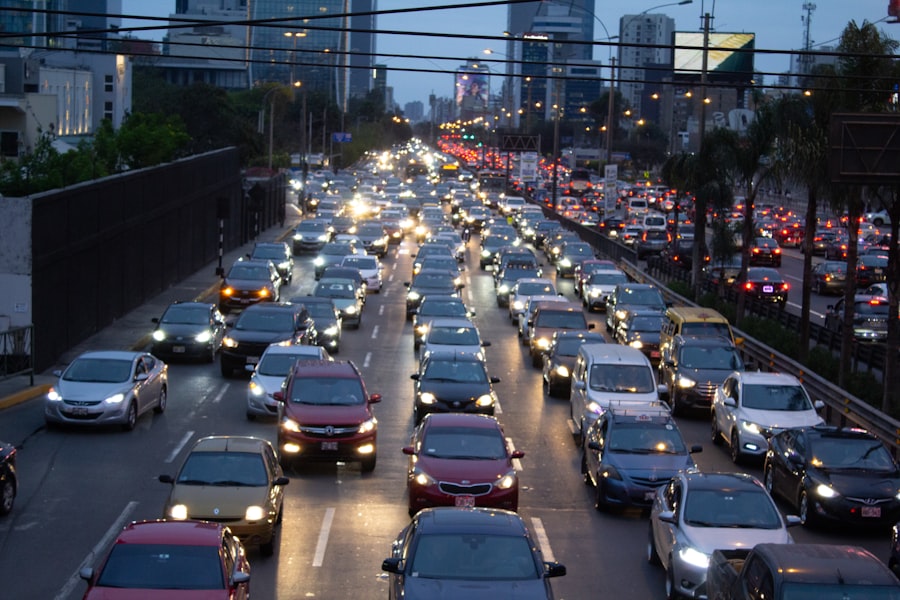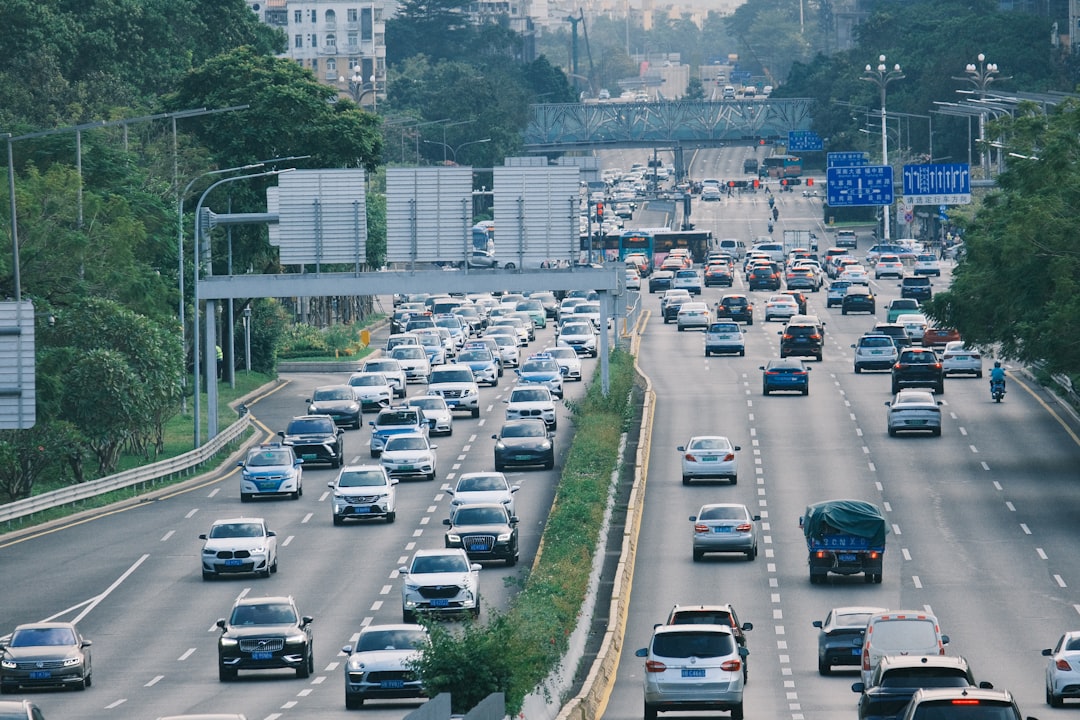New York City, a bustling metropolis known for its iconic skyline and vibrant culture, faces a persistent challenge: traffic congestion. The streets of NYC are often choked with vehicles, creating a daily struggle for commuters, residents, and visitors alike. This congestion is not merely an inconvenience; it has far-reaching implications for the city’s economy, environment, and quality of life.
As the population continues to grow and the number of vehicles on the road increases, the urgency to address this issue becomes more pronounced. The city’s infrastructure, originally designed for a much smaller population, is now under immense strain, leading to longer travel times and increased frustration among drivers. The phenomenon of traffic congestion in New York City is exacerbated by various factors, including the high density of the urban environment, limited road space, and a public transportation system that, while extensive, is often overwhelmed.
The result is a complex web of delays and inefficiencies that affect not only those behind the wheel but also pedestrians and cyclists navigating the same crowded streets. As the city grapples with these challenges, innovative solutions are being explored to alleviate congestion and improve overall mobility. One such solution gaining traction is traffic congestion pricing, a strategy that has been implemented in various forms around the world.
Key Takeaways
- NYC faces severe traffic congestion, leading to economic losses and environmental impact.
- Traffic congestion in NYC leads to increased travel time, air pollution, and fuel consumption.
- Traffic congestion pricing aims to reduce traffic by charging drivers for entering certain areas at peak times.
- London and Singapore have successfully implemented traffic congestion pricing to reduce traffic and improve air quality.
- The proposal for traffic congestion pricing in NYC aims to reduce traffic, improve air quality, and generate revenue for public transportation.
The Impact of Traffic Congestion on NYC
The impact of traffic congestion on New York City is multifaceted, affecting economic productivity, environmental sustainability, and public health. Economically, congestion leads to significant losses in productivity as commuters spend hours stuck in traffic instead of engaging in work or leisure activities. According to estimates, the cost of congestion in NYC runs into billions of dollars annually, with lost time translating into lost wages and decreased economic output.
Businesses also suffer as delivery times increase and customers face challenges reaching their destinations. This economic burden is felt most acutely by those who rely on timely transportation for their livelihoods. Environmentally, traffic congestion contributes to increased air pollution and greenhouse gas emissions.
Vehicles idling in traffic produce harmful pollutants that degrade air quality and pose health risks to residents. The concentration of emissions in densely populated areas can lead to respiratory issues and other health problems, disproportionately affecting vulnerable populations. Furthermore, the reliance on fossil fuels for transportation exacerbates climate change, making it imperative for cities like New York to seek sustainable alternatives.
Addressing traffic congestion is not just about improving travel times; it is also about fostering a healthier environment for all New Yorkers.
What is Traffic Congestion Pricing?

Traffic congestion pricing is an innovative approach designed to manage road usage by charging drivers a fee to enter certain congested areas during peak hours. The concept is rooted in the idea that by placing a monetary value on road space, cities can encourage more efficient use of their transportation networks. This pricing mechanism aims to reduce the number of vehicles on the road during busy times, thereby alleviating congestion and promoting alternative modes of transportation such as public transit, cycling, or walking.
The implementation of congestion pricing typically involves the use of electronic tolling systems that automatically charge vehicles as they enter designated zones. This technology allows for seamless transactions without the need for physical toll booths, minimizing delays at entry points. The revenue generated from these fees can be reinvested into public transportation infrastructure and services, creating a virtuous cycle that benefits both commuters and the environment.
By incentivizing off-peak travel and reducing reliance on personal vehicles, congestion pricing seeks to create a more balanced and sustainable urban mobility landscape.
The Success of Traffic Congestion Pricing in Other Cities
| City | Implementation Year | Reduction in Traffic | Revenue Generated |
|---|---|---|---|
| London | 2003 | 30% | £1.2 billion |
| Stockholm | 2006 | 20% | SEK 628 million |
| Singapore | 1975 | 25% | SGD 150 million |
Cities around the globe have successfully implemented traffic congestion pricing with notable results. London, for instance, introduced its congestion charge in 2003, leading to a significant reduction in traffic volumes within the charging zone. Studies indicate that vehicle traffic decreased by approximately 30%, while public transport usage increased as commuters sought alternatives to driving.
The program not only improved travel times but also generated substantial revenue that was reinvested into public transit improvements. Similarly, Singapore has long been recognized as a pioneer in congestion pricing. The city-state employs an electronic road pricing system that adjusts fees based on real-time traffic conditions.
This dynamic pricing model has effectively managed congestion while maintaining high levels of mobility for residents. The success seen in these cities serves as a compelling case study for New York City as it contemplates its own approach to managing traffic congestion through pricing mechanisms.
The Proposal for Traffic Congestion Pricing in NYC
In light of the challenges posed by traffic congestion, New York City has proposed implementing its own congestion pricing plan aimed at reducing vehicle traffic in Manhattan’s busiest areas. The proposal seeks to establish a tolling system that would charge drivers entering designated zones during peak hours. This initiative has garnered significant attention and debate among city officials, residents, and advocacy groups alike.
Proponents argue that congestion pricing is a necessary step toward addressing the city’s transportation woes while generating much-needed revenue for public transit improvements. They contend that by discouraging unnecessary vehicle trips into congested areas, the plan could lead to shorter travel times and enhanced air quality. However, opponents raise concerns about potential inequities associated with the pricing structure and its impact on low-income residents who may rely on personal vehicles for their daily commutes.
Potential Benefits of Traffic Congestion Pricing in NYC

The potential benefits of implementing traffic congestion pricing in New York City are numerous and far-reaching. One of the most significant advantages is the anticipated reduction in traffic volumes during peak hours. By discouraging unnecessary trips into congested areas, the city could experience smoother traffic flow, leading to shorter travel times for all road users.
This improvement would not only enhance the commuting experience but also contribute to increased economic productivity as businesses benefit from more efficient logistics. Additionally, revenue generated from congestion pricing could be earmarked for vital investments in public transportation infrastructure. Enhancing subway and bus services would provide commuters with viable alternatives to driving, further reducing reliance on personal vehicles.
Improved public transit options could lead to increased ridership and greater accessibility for all residents, particularly those in underserved communities. Furthermore, by decreasing vehicle emissions associated with idling in traffic, congestion pricing could contribute to improved air quality and public health outcomes across the city.
Potential Drawbacks of Traffic Congestion Pricing in NYC
Despite its potential benefits, traffic congestion pricing is not without its drawbacks and challenges. One primary concern revolves around equity issues; critics argue that imposing fees on drivers could disproportionately affect low-income individuals who may not have access to reliable public transportation alternatives. For many residents living in outer boroughs or areas with limited transit options, personal vehicles may be essential for commuting to work or accessing essential services.
Moreover, there are concerns about how the pricing structure would be designed and implemented.
Addressing these equity concerns will be crucial in garnering public support for any proposed congestion pricing plan.
Addressing Equity Concerns with Traffic Congestion Pricing
To ensure that traffic congestion pricing is equitable and just, it is essential for policymakers to engage with community stakeholders and consider various strategies aimed at mitigating potential negative impacts on low-income residents. One approach could involve implementing tiered pricing structures that take into account income levels or providing subsidies for low-income drivers who may be disproportionately affected by the fees. Additionally, investing in robust public transportation options is critical to providing viable alternatives for those who may be priced out of driving into congested areas.
Expanding bus routes, increasing subway frequency, and enhancing accessibility features can help ensure that all residents have access to reliable transit options regardless of their socioeconomic status. By prioritizing equity in the design and implementation of congestion pricing policies, New York City can work toward creating a more inclusive transportation system that benefits everyone.
The Role of Public Transportation in Alleviating Traffic Congestion
Public transportation plays a pivotal role in alleviating traffic congestion in urban environments like New York City. A well-functioning transit system can significantly reduce the number of vehicles on the road by providing commuters with efficient alternatives to driving. In NYC, the subway system serves millions of riders daily, offering a fast and reliable means of transportation that can help ease pressure on congested roadways.
To maximize the effectiveness of public transportation in combating congestion, it is essential to invest in infrastructure improvements and service enhancements. Upgrading aging subway lines, expanding bus rapid transit routes, and ensuring seamless connections between different modes of transport can encourage more residents to choose public transit over personal vehicles. Additionally, promoting initiatives such as carpooling or vanpooling can further reduce single-occupancy vehicle trips and contribute to a more sustainable urban mobility landscape.
The Importance of Public Input in Implementing Traffic Congestion Pricing
As New York City considers implementing traffic congestion pricing, engaging with the public is crucial for ensuring transparency and building trust among residents. Public input can provide valuable insights into community concerns and preferences regarding the proposed plan. Hosting town hall meetings, conducting surveys, and facilitating discussions with various stakeholders can help policymakers understand how different segments of the population may be affected by congestion pricing.
Moreover, incorporating public feedback into the design of the pricing structure can lead to more equitable outcomes that address community needs. By actively involving residents in the decision-making process, city officials can foster a sense of ownership over the initiative and increase public support for its implementation. Ultimately, prioritizing public engagement will be key to creating a successful congestion pricing plan that reflects the diverse perspectives of New Yorkers.
The Future of Traffic Congestion Pricing in NYC
The future of traffic congestion pricing in New York City remains uncertain but holds promise as a potential solution to one of the city’s most pressing challenges.
While there are valid concerns regarding equity and accessibility that must be addressed, the experiences of other cities demonstrate that such initiatives can lead to positive outcomes when implemented thoughtfully.
As discussions around congestion pricing evolve, it will be essential for city leaders to prioritize public engagement and consider diverse perspectives throughout the process. By fostering collaboration among stakeholders and investing in robust public transportation options, New York City can work toward creating a more efficient and equitable transportation system that benefits all residents. Ultimately, traffic congestion pricing could play a pivotal role in shaping the future of urban mobility in one of the world’s most dynamic cities.
New York City’s traffic congestion pricing plan has been a topic of significant discussion and debate, as it aims to reduce traffic in the bustling city while generating revenue for public transportation improvements. For a deeper understanding of how urban planning and geographic considerations play a role in such initiatives, you might find this related article insightful. It explores various aspects of urban geography and how they intersect with policy-making in major cities like New York.
WATCH THIS! The Real Cost of NYC Living: Your Wallet, Sanity, and Subway Survival Skills
FAQs
What is NYC traffic congestion pricing?
NYC traffic congestion pricing is a system that charges vehicles a fee for entering certain parts of the city during peak traffic hours. The goal is to reduce traffic congestion and improve air quality.
How does NYC traffic congestion pricing work?
Under the proposed plan, vehicles entering a designated congestion zone in Manhattan would be charged a fee. The fee would vary based on the time of day and the vehicle’s emissions.
Why is NYC considering implementing traffic congestion pricing?
NYC is considering congestion pricing as a way to reduce traffic congestion, improve air quality, and generate revenue for public transportation improvements.
What are the potential benefits of NYC traffic congestion pricing?
Potential benefits of congestion pricing include reduced traffic congestion, improved air quality, and increased funding for public transportation infrastructure.
What are the potential drawbacks of NYC traffic congestion pricing?
Critics of congestion pricing argue that it could disproportionately impact low-income drivers and businesses that rely on vehicle transportation. There are also concerns about the potential for increased traffic on alternate routes.
When is NYC traffic congestion pricing expected to be implemented?
The implementation timeline for NYC traffic congestion pricing is still being determined, but it is expected to be rolled out in the coming years.
